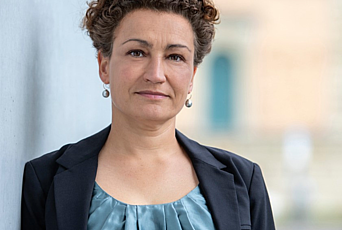A Face Out of Place

In 2024, Rubina Raja, Member (2019) in the School of Historical Studies, received a Semper Ardens Advance grant from the Carlsberg Foundation for her project titled “Locally Crafted Empires” (LoCiS). This project builds on work that she conducted during her time at IAS, namely a study of more than 4,000 Roman-period portraits from Palmyra in Syria. Below, Raja shares, in her own words, an up-close look at one of the so-called “loose heads” that make up the Palmyra Portrait Project.
Around 4,000 portraits survive from Palmyra in Syria, making it the largest sculptural corpus from the ancient world outside of Rome itself. That makes it hugely significant. But only 1 percent of that portraiture has actually been found in its original archaeological context—that is, the place it was set up after production in antiquity.
This almost life-size limestone head of a boy came to Ny Carlsberg Glyptotek, Copenhagen in the 1880s as part of brewing magnate and art collector Carl Jacobson’s efforts to buy up the largest collection of Palmyrene portraits that survives from the ancient world. The head dates to 230 C.E.


Its procurement was less than salubrious: the head has been chopped out of the larger relief of which it was originally a part. Such actions by nineteenth century “collectors’” networks were not unusual—this is why we have so many loose heads from Palmyra! And actually, that’s how it is with most archaeological material that entered European collections in the eighteenth and nineteenth centuries. The looting of graves and archaeological sites was common back then, and remains so today in Syria, the wider Mediterranean, and beyond.
One of the problems with a lot of archaeological material in general, in collections around the world, is that they have no primary context. This head is a great example; because of its “classicizing” style—i.e., its imitation of ancient Greek sculptural styles—David Simonson, who first catalogued the head in 1889, believed that it could certainly not be Palmyrene, but had to be imported from Greece.
Today, we know that this is entirely wrong. The head is made out of the local limestone sourced right outside of Palmyra.
It would have been part of a relief showing a scene of banqueting or religious activity such as a sacrifice. The figure would likely have represented a servant wearing a local costume.
It might be tempting to say, “Oh, the local Palmyrans were simply mimicking beautiful, Greek sculptures that they had seen in other places,” but when we consider the likely context of the object, we actually see that they picked and chose various elements (local, eastern, and “classicizing”) for unique, local situations.
The realization that this was not an imported Greek piece and was instead produced onsite by local craftsmen in local material flips the worldview of what sort of place Palmyra was in the ancient world.
Context forces us to think about the ancient world with a completely different perspective, opening up avenues for new discussions of knowledge. So, even if we can’t place things back exactly in the primary situation in which they would have been found, we still need to think around the piece and around its original function, and not make assumptions about it.
Objects make us think about things in a nonverbal way. We can then put that thinking into our own narrative about a place or about the ancient world more broadly. That’s what I find exciting about objects—that they give us insights into stories or ideas or ways of dealing with the past, and ways that the past dealt with their contemporary world, which texts that survive from antiquity simply can’t.


